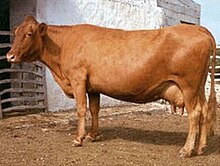 Menorquina cow Menorquina cow | |
| Conservation status | FAO (2007): endangered-maintained |
|---|---|
| Other names |
|
| Country of origin | Spain |
| Distribution | Menorca, Balearic Islands |
| Standard | Conselleria d’Agricultura i Pesca (in Catalan) |
| Use | dairy |
| Traits | |
| Weight |
|
| Coat | red |
| Horn status | hornless |
| |
The Menorquina is an endangered breed of cattle from the Mediterranean island of Menorca, in the Spanish autonomous community of the Balearic Islands. It belongs to the group of convex-profiled red cattle, whose distribution across the northern Mediterranean region is thought to have followed the path of the Bell-Beaker Culture. It is one of only two autochthonous Spanish breeds of dairy cattle, the other being the Pasiega. The milk is particularly suitable for cheese production, and is used to make Mahón cheese, which has DOP status.
History
Cattle have been present in the Balearic Islands since the time of the Bell-Beaker Culture. Perforated beakers of this period found on the island of Mallorca are believed to be cheese-strainers. In Menorca, where there is no Bell-Beaker pottery, the presence of cattle is documented from the Talaiotic Culture of the first millennium BC, both by cattle bones excavated from talaiots such as those of Torre d'en Galmés and Trepucó [ca], and by artefacts such as the bronze statuette of a calf found at the taula of Torralba d'en Salord [es] in 1980.
The Menorquina was the only cattle breed on Menorca. When importations of modern specialised dairy cattle began in the twentieth century, it was rapidly displaced by these and numbers fell sharply. The survival of the breed is largely due to the efforts of a local vet, Gabriel Seguí, who in the 1940s brought together the remaining stock on his estates.
In 1991 the population was reported to be 184 head. The Menorquina was classified among the breeds "at risk of extinction" by the Ministerio de Agricultura, Alimentación y Medio Ambiente, the Spanish ministry of agriculture, on 7 November 1997. A breeders' association, the Associació de Ramaders de Bestiar Boví de Raça de Menorca, was formed in 1998, and the Menorquina breed received official recognition on 31 March 2000. At the end of 2014 the total population was recorded as 1536, of which 1196 were female and 340 male.
Use and management
The Menorquina was formerly a triple-purpose breed, used as a draught animal and for milk and meat production. It is now raised mainly for dairy use, and is one of only two autochthonous dairy cattle breeds of Spain, the other being the Pasiega of Cantabria. Milk yield may exceed 4000 litres per lactation. The milk is not usually sold, but is used to make Formatge de Maó, a traditional local cheese which has European Union DOP status.
The Menorquina is well adapted to the Mediterranean climate and landscape, and is used in vegetation management. It has a high level of resistance to piroplasmosis, which is endemic to Menorca.
References
- Barbara Rischkowsky, D. Pilling (eds.) (2007). List of breeds documented in the Global Databank for Animal Genetic Resources, annex to The State of the World's Animal Genetic Resources for Food and Agriculture. Rome: Food and Agriculture Organization of the United Nations. ISBN 9789251057629. Accessed January 2016.
- ^ Miguel Fernández Rodríguez, Mariano Gómez Fernández, Juan Vicente Delgado Bermejo, Silvia Adán Belmonte, Miguel Jiménez Cabras (eds.) (2009). Guía de campo de las razas autóctonas españolas (in Spanish). Madrid: Ministerio de Medio Ambiente y Medio Rural y Marino. ISBN 9788449109461.
- Raza bovina Menorquina: Datos Generales (in Spanish). Ministerio de Agricultura, Alimentación y Medio Ambiente. Accessed January 2016.
- William H. Waldren (1998). The Beaker culture of the Balearic Islands: an inventory of evidence from caves, rock shelters, settlements and ritual sites. Oxford: Archaeopress. ISBN 9780860548904.
- Breed data sheet: Menorquina/Spain. Domestic Animal Diversity Information System of the Food and Agriculture Organization of the United Nations. Accessed January 2016.
- L'associació (in Catalan). Associació de Ramaders de Bestiar Boví de Raça de Menorca. Accessed January 2016.
- (15 April 2000). Ordre del conseller d’Agricultura i Pesca, de 31 de març de 2000 per la qual es crea el llibre genealògic de la raça bovina menorquina i se’n regula el funcionament (in Catalan). Butlletí Oficial de les Illes Balears 48: 5857–5859.
- Raza bovina Menorquina: Datos Censales (in Spanish). Ministerio de Agricultura, Alimentación y Medio Ambiente. Accessed January 2016.
- ^ Raza bovina Menorquina: Usos y sistema de explotación (in Spanish). Ministerio de Agricultura, Alimentación y Medio Ambiente. Accessed January 2016.
- Valerie Porter, Lawrence Alderson, Stephen J.G. Hall, D. Phillip Sponenberg (2016). Mason's World Encyclopedia of Livestock Breeds and Breeding (sixth edition). Wallingford: CABI. ISBN 9781780647944.
| Cattle breeds of Spain | |||||
|---|---|---|---|---|---|
| These are the cattle breeds considered in Spain to be wholly or partly of Spanish origin. Inclusion here does not necessarily imply that a breed is predominantly or exclusively Spanish. | |||||
| |||||
|